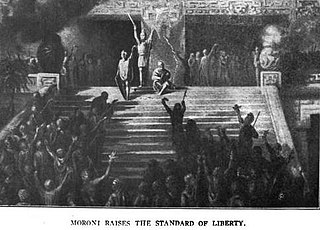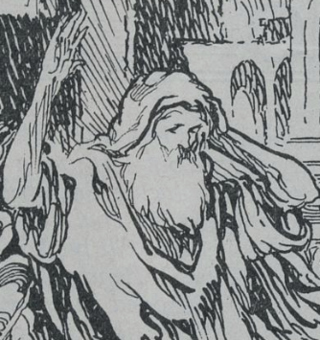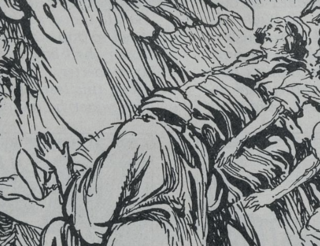
The Book of Alma: The Son of Alma, usually referred to as the Book of Alma, is one of the books that make up the Book of Mormon. The title refers to Alma the Younger, a prophet and "chief judge" of the Nephites. Alma is the longest book in the Book of Mormon and consists of sixty-three chapters, taking up almost a third of the volume.

The Book of Helaman is one of the books that make up the Book of Mormon, a text held sacred by churches within the Latter Day Saint movement, including the Church of Jesus Christ of Latter-day Saints. The book continues the history of the Nephites and the Lamanites from approximately 50 BC to 1 BC. It discusses political unrest among the Nephites and the formation of a group of secret dissenters called the Gadianton Robbers. Helaman, son of Helaman leads the Nephites for a time, and his sons Nephi and Lehi go on a successful mission to the Lamanites. When Nephi returns home, he correctly identifies the murderer of the chief judge using his prophetic powers, and sends a famine to the Nephite which lasts three years. After a digression from Mormon, the book of Helaman ends with Samuel the Lamanite's prophecy of the signs that will precede Christ's birth and death. Helaman deals with themes of external and internal conflict, hidden information, Nephite racism, and Mormon's views of history as deduced by his redaction of it.
The Book of Mosiah is one of the books which make up the Book of Mormon. The title refers to Mosiah II, a king of the Nephites at Zarahemla. The book covers the time period between ca 130 BC and 91 BC, except for when the book has a flashback into the Record of Zeniff, which starts at ca 200 BC, according to footnotes. Aside from stating that it was abridged by Mormon, the text says nothing about its authorship. Mosiah is twenty-nine chapters long.
The Book of Ether is one of the books of the Book of Mormon. It describes the Jaredites, descendants of Jared and his companions, who were led by God to the Americas shortly after the confusion of tongues and the destruction of the Tower of Babel. Ether consists of fifteen chapters.

According to the Book of Mormon, the Nephites are one of four groups to have settled in the ancient Americas. The term is used throughout the Book of Mormon to describe the religious, political, and cultural traditions of the group of settlers.

The Lamanites are one of the four ancient peoples described as having settled in the ancient Americas in the Book of Mormon, a sacred text of the Latter Day Saint movement. The Lamanites also play a role in the prophecies and revelations of the Doctrine and Covenants, another sacred text in the Latter Day Saint movement.

According to the Book of Mormon, Lehi was a prophet who lived in Jerusalem during the reign of King Zedekiah. In First Nephi, Lehi is rejected for preaching repentance and he leads his family, including Sariah, Laman, Lemuel, Sam, and Nephi, into the wilderness. He sends his sons back to recover the plates of brass and once more for the family of Ishmael. As they travel, Lehi has a vision of the tree of life in which most of his family, excepting Laman and Lemuel, accepts God. He also prophesies Christ's coming 600 years in the future.

Mormon is believed by members of the Church of Jesus Christ of Latter-day Saints to be a prophet-historian and a member of a tribe of indigenous Americans known as the Nephites, one of the four groups described in the Book of Mormon as having settled in the ancient Americas.

Alma is a Nephite prophet in the Book of Mormon. Initially a priest who serves in the court of King Noah, when a prophet named Abinadi preaches to the court Alma concurs with Abinadi and affirms that what the prophet said is true. For this, Noah banishes Alma and tries to have him killed. After leaving the court, Alma goes on to found a church among Noah's subjects. He eventually leads these churchgoers out from Noah's lands, through a sojourn under Lamanite rule, and to the land of Zarahemla, where their ancestors had come from a few generations earlier, where Alma becomes high priest of the Nephites' church.

King Noah is a Nephite king in the Book of Mormon who appears in the Book of Mosiah. Noah rules over a Nephite colony who came from Zarahemla and settled in the land of Lehi-Nephi, succeeding his father, Zeniff. In the Book of Mosiah, King Noah breaks away from his father's righteous teachings, committing "all manner of wickedness." Noah and his priests sentence the prophet Abinadi, who prophesied of his kingdom's downfall if they did not repent, to death by fire. During a Lamanite invasion, Noah and some of his people flee the land, and those who remain are subjected to Lamanite control. Noah attempts to forbid his men from returning to their families, and they burn him at the stake. Noah is succeeded by his son, Limhi.

In the Book of Mormon, Alma, the son of Alma is a Nephite prophet often referred to as Alma the Younger to distinguish him from his father, who is often referred to as Alma the Elder. These appellations, "the Younger" and "the Elder," are not used in the Book of Mormon; they are distinctions made by scholars, useful because both individuals were prominent during the same time period in the Book of Mormon's story and filled a similar cultural and religious role. Alma is the namesake of the Book of Alma.

In the Book of Mormon, Ammon is a prominent Nephite missionary and a son of King Mosiah. He originally opposes the church, but along with his brothers and Alma the Younger, is miraculously converted. Following his conversion he serves a mission to the Lamanites and converts Lamoni and his people.

According to the Book of Mormon, Ether is a Jaredite prophet, one of the last surviving Jaredites, and primary author of the Book of Ether.

Korihor is an anti-christ described in Alma 30 in the Book of Mormon.

In the Book of Mormon, chapters 9 through 22 of the Book of Mosiah are identified as the Record of Zeniff. These chapters contain the story of a group of Nephites, led by Zeniff, who leave the land of Zarahemla and return to their former land, known as the land of Nephi, which was then occupied by the Lamanites, their traditional enemies. Although the attempt to establish themselves among the Lamanites is successful for a short time, the people of Zeniff are ultimately enslaved and forced to pay tribute to the Lamanite king. They are later rescued by an expedition from Zarahemla sent to discover their fate. The Record of Zeniff records the reigns of Zeniff, his son Noah and grandson Limhi. The timespan is approximately 75 years.

According to the Book of Mormon, the plates of Nephi, consisting of the large plates of Nephi and the small plates of Nephi, are a portion of the collection of inscribed metal plates which make up the record of the Nephites. This record was later abridged by Mormon and inscribed onto gold plates from which Joseph Smith translated the Book of Mormon after an angel revealed to him the location where the plates were buried on a hill called Cumorah near the town of Palmyra, New York.

According to the Book of Mormon, Amaleki was one of several Nephite record keepers who maintained records on metal plates known as the plates of Nephi. The Book of Mormon refers to the small plates of Nephi and the large plates of Nephi. Nephi began writing on the small plates about 570 BC. Nephi's brother Jacob and his descendants began keeping records of sacred and religious matters on the small plates around 544 BC. Seven of Jacob's descendants, including Amaleki, wrote on the plates. Amaleki recorded his account on the plates about 130 BC. He states at the end of his writings that the plates are full. He received the plates of Nephi from his father Abinadom and penned 18 verses in the Book of Omni. He was the last person to write in the small plates of Nephi. Having no descendants, Amaleki gave the small plates to King Benjamin.
This chronology outlines the major events in the history of the Book of Mormon, according to the text. Dates given correspond to dates in the footnotes of the Church of Jesus Christ of Latter-day Saints edition of the Book of Mormon.

Moroni, according to the Book of Mormon, was the last Nephite prophet, historian, and military commander who lived in the Americas in the late fourth and early fifth centuries. He is later known as the Angel Moroni, who presented the golden plates to Joseph Smith, who translated the plates upon which the Book of Mormon was originally written.









